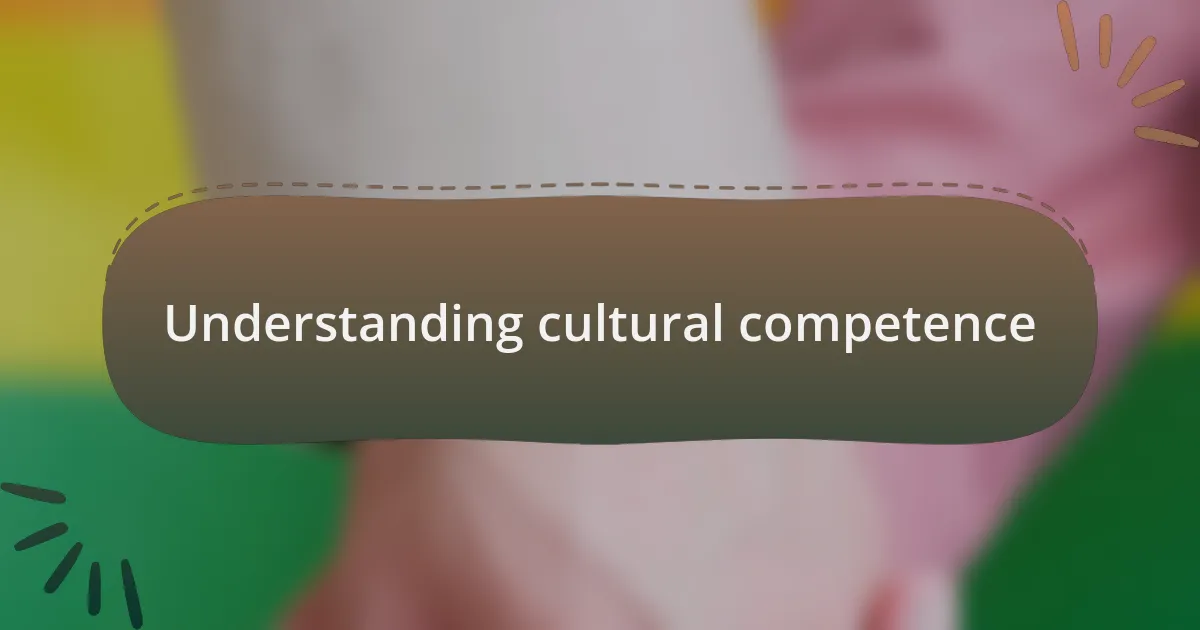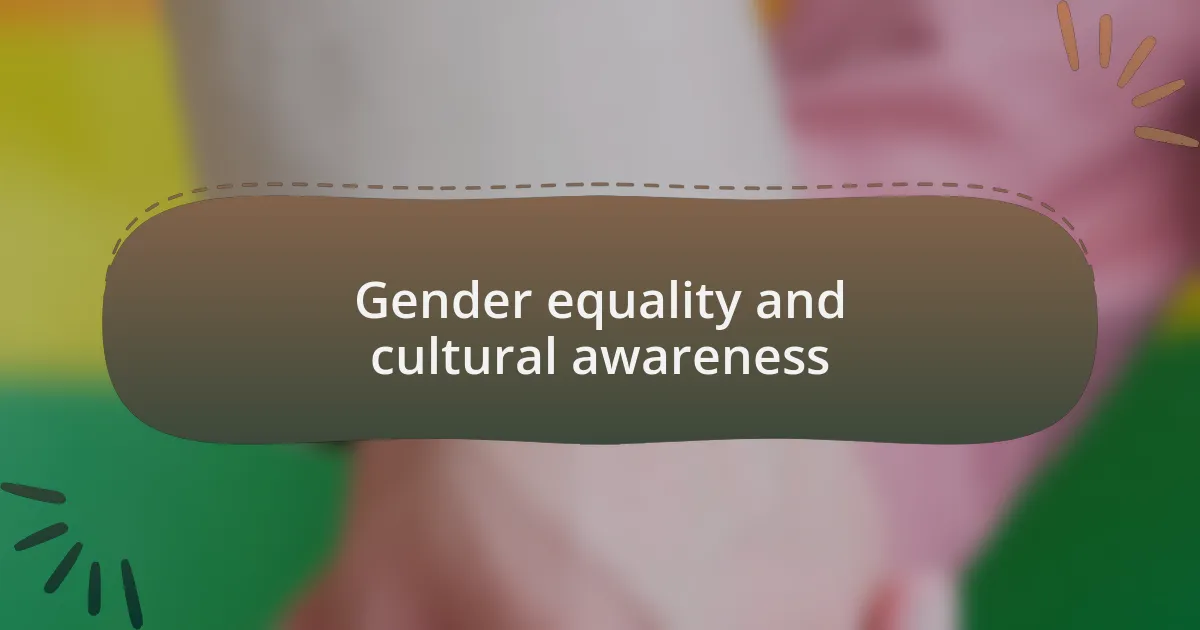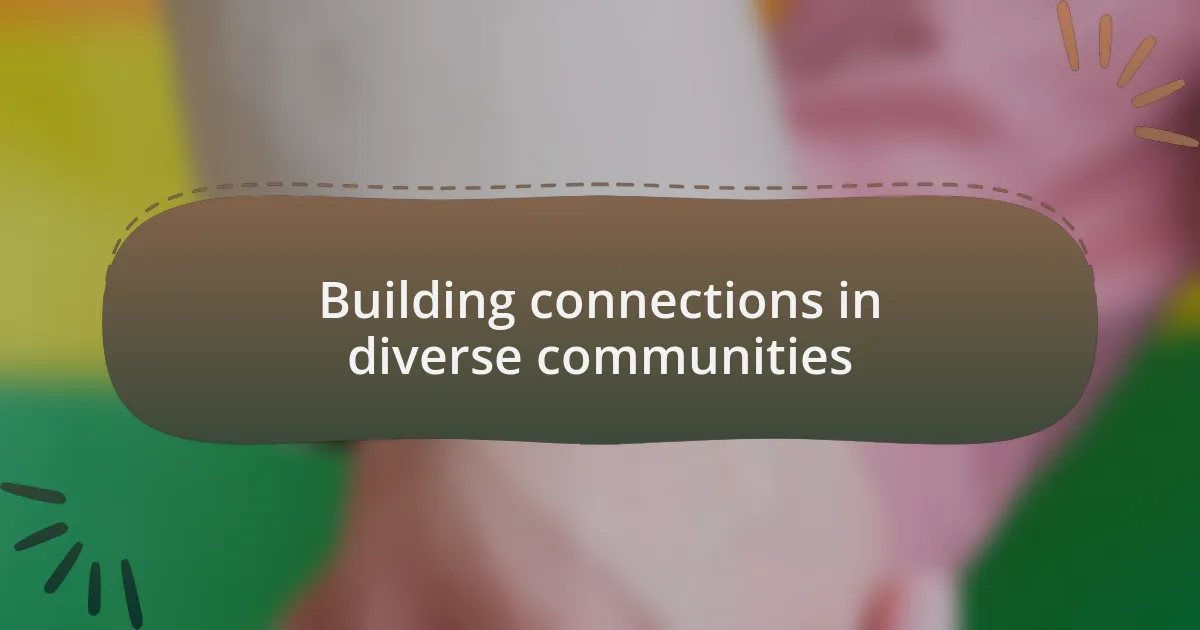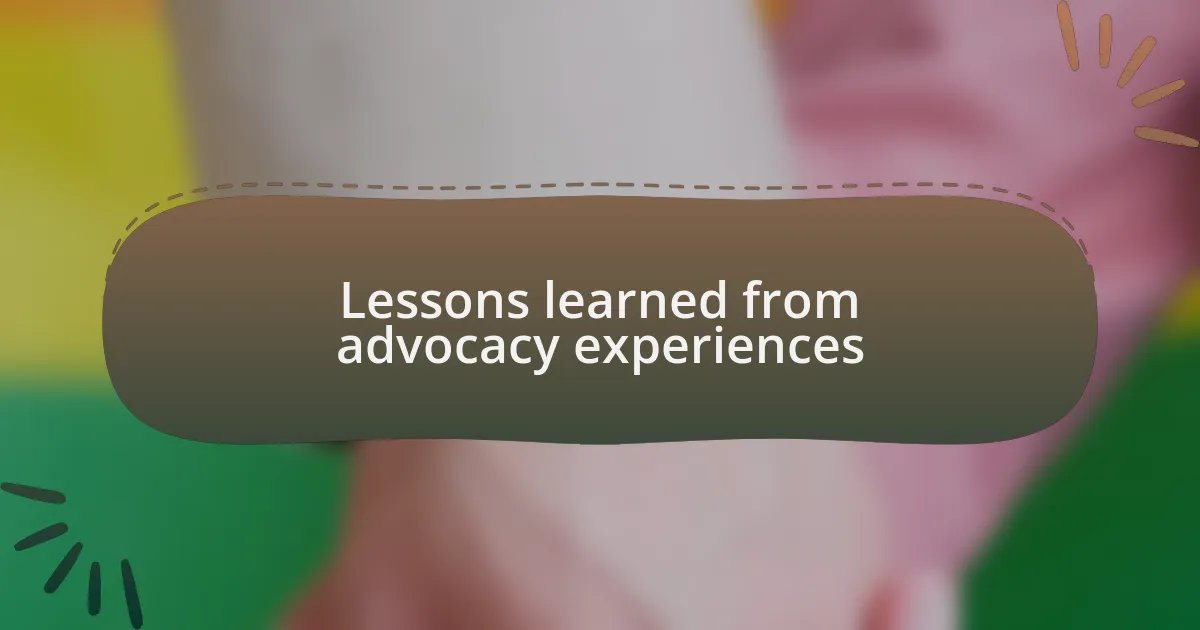Key takeaways:
- Cultural competence entails understanding and valuing diverse perspectives, requiring ongoing effort and openness to discomfort for personal growth.
- Gender equality advocacy necessitates cultural awareness, recognizing that different cultural narratives influence strategies for promoting equality.
- Building genuine connections through shared experiences fosters empathy and facilitates mutual understanding in diverse communities.
- Effective advocacy involves listening deeply, ensuring inclusive representation, and recognizing that meaningful change takes time and persistence.

Understanding cultural competence
Cultural competence is the ability to understand, appreciate, and effectively interact with diverse cultures. I remember the first time I truly grasped this concept while volunteering in a multicultural community center. It struck me how our different backgrounds shaped not just our identities but also our interactions; it was eye-opening to see how cultural misunderstandings could lead to conflict, but also how empathy could bridge those gaps.
Engaging with diverse cultures often raises significant questions: How do our experiences shape our perceptions of others? I found myself reflecting on my own biases while attending workshops where participants shared their stories. Those moments of vulnerability made me appreciate the richness of varied perspectives and the importance of active listening. It’s not merely about tolerance; it’s about valuing what each culture brings to the table.
Developing cultural competence requires ongoing effort and an open heart. While navigating new cultural landscapes, I’ve learned to embrace discomfort, knowing it’s often a sign of growth. For instance, during a discussion on gender roles in different cultures, I realized that my assumptions were not universal. Confronting this discomfort enabled me to foster deeper connections, turning what could have been a barrier into a bridge for mutual understanding.

Gender equality and cultural awareness
Understanding gender equality within a cultural context has been an essential part of my journey. One memorable experience was attending a panel discussion on women’s roles across different societies. It was fascinating to see how certain cultural practices perpetuated gender stereotypes, and I couldn’t help but ask myself: What can we learn from these differences? This question prompted some deep reflection on how cultural narratives can empower or restrict, influencing the path toward true gender equality.
I recall a time when I participated in a community workshop focused on gender disparities in education globally. Hearing firsthand accounts from participants about the challenges faced by women in various cultures made it clear to me that the fight for gender equality isn’t a one-size-fits-all issue. It ignited a passion within me to advocate for more tailored approaches, as I realized that cultural awareness plays a pivotal role in shaping effective strategies for change.
Navigating conversations around gender and culture can evoke a range of emotions, from frustration to hope. I often find myself grappling with the complexities: How do we respect cultural practices while advocating for equality? This delicate balance is something I strive to understand better each day, recognizing that bridging these gaps requires both courage and empathy. It’s an ongoing process that calls for continuous learning and an open dialogue about our shared humanity.

Building connections in diverse communities
Building connections in diverse communities is a transformative experience that often begins with genuine curiosity. I remember joining a local multicultural event where various traditions were showcased. Engaging with families from different backgrounds, I was struck by the stories they shared about their journeys and struggles, and it made me realize how vital personal connections are in fostering mutual understanding.
Surrounding myself with diverse voices has taught me that each person carries a unique narrative. I recall a deep conversation with an immigrant woman who spoke about her challenges in navigating a new society while holding onto her cultural identity. Her resilience resonated with me, reinforcing the idea that building relationships across cultures is not just about sharing ideas—it’s about sharing lived experiences that can break down barriers and create empathy.
Embracing diversity often means entering uncomfortable spaces. I’ve learned that asking questions and being open to learning can lead to connections that enrich us all. For instance, after attending a cultural festival, I felt compelled to reach out to the organizers to understand their perspectives. This inquiry not only deepened my appreciation for their culture but also sparked a friendship grounded in respect and shared goals for gender equality. How often do we take the time to really listen to those around us? In my opinion, that willingness can be the key to unlocking stronger ties within our communities.

Personal experiences in advocacy
Personal experiences in advocacy have profoundly shaped my understanding of gender equality. I vividly recall my first visit to a women’s shelter, where I volunteered to help with workshops. Listening to the women share their stories of survival and strength left a lasting impression on me. It was a stark reminder that advocacy isn’t just about statistics; it’s about real lives and the support systems that can empower change.
Reflecting on my journey, I recall a powerful moment during a panel discussion I organized, where participants shared their experiences with gender discrimination. One speaker, who was a single mother, opened up about her struggles in balancing work and childcare without reliable support. Her vulnerability struck a chord with the audience, including me. I found myself thinking, how many similar stories go unheard? This experience reinforced my belief in the importance of empowering voices that often remain silenced.
I’ve also faced my own challenges in understanding cultural nuances within gender advocacy. One encounter that stood out was with a colleague from a different cultural background who held contrasting views on traditional gender roles. Instead of dismissing our differences, I approached the situation as a learning opportunity, leading to enlightening discussions that broadened my perspective. It made me wonder: what valuable insights are we missing when we avoid conversations that challenge our viewpoints? Embracing these dialogues has enriched my advocacy work in ways I hadn’t anticipated.

Strategies for promoting gender equality
One effective strategy for promoting gender equality that I’ve found impactful is community education. I once facilitated a workshop aimed at high school students, focusing on the importance of respecting diverse identities and perspectives. The easy, open lines of communication allowed students to express their beliefs and challenges freely, ultimately leading to a deeper understanding of their peers’ experiences. Have you ever seen a lightbulb moment when someone grasps a concept that they once overlooked? Those moments remind me why education is a tool of empowerment.
In my experience, creating safe spaces for dialogue has proven invaluable. I remember initiating a gender discussion circle in my neighborhood, where participants shared personal narratives about gender roles in their families. It was inspiring to witness how people became more vulnerable with each story shared. This kind of emotional connection can dismantle stereotypes and foster empathy. Isn’t it fascinating how a simple conversation can shift community attitudes and create a ripple effect of change?
Lastly, leveraging social media as a tool for advocacy has been particularly transformative in my work. I recall launching a campaign that encouraged local influencers to share their stories and resources related to gender equality. The response was overwhelming, with people reaching out to discuss their feelings about gender norms. Have you ever engaged with someone online and felt that connection grow from a shared struggle? It’s a reminder of the collective power we hold in amplifying voices. By harnessing these strategies, we can foster a culture of understanding and respect, paving the way for a more equitable future.

Lessons learned from advocacy experiences
Through my advocacy experiences, I’ve learned that listening is a powerful tool. During a community forum, I sat quietly as participants shared their stories surrounding gender inequality. The weight of their experiences taught me that sometimes the most profound impact comes not from speaking, but from truly hearing others. Have you ever realized that listening can open doors to understanding that you didn’t even know were closed?
Another important lesson emerged from a failure I encountered when organizing a rally. Despite my intentions, I overlooked the need for inclusive representation among speakers, which led to criticism from community members. This experience underscored the significance of not just advocating for diverse voices but actively ensuring those voices are heard. How often do we think we know what’s best without involving the very people we aim to support?
Lastly, I’ve come to appreciate the value of patience in advocacy work. I once conducted a series of training sessions on gender bias in workplaces, expecting immediate change in attitudes and practices. However, the slow, gradual shifts made me realize that true transformation takes time and persistent effort. Doesn’t it surprise you how small steps can lead to significant change when we commit to the advocacy journey? It’s a humbling reminder that progress may not always be swift, but each effort counts.